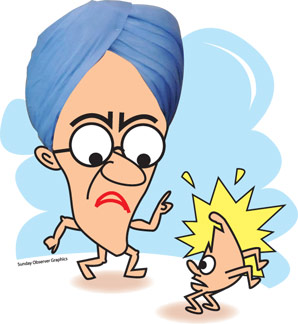India an opportunity not a threat - Indian Commerce Secy
by Gamini Warushamana
[email protected]
India is a huge market and there are tremendous opportunities with
the opening of trade in services with India under ILCEPA, the commerce
secretary of India Gopal K. Pillai said in Colombo last week
 The officials of the two countries concluded the final draft of the
India-Sri Lanka Comprehensive Economic Partnership Agreement (ILCEPA) on
Wednesday and on Thursday Pillai addressed a seminar on “Opportunities
and challenges of liberalising bilateral trade between the two
countries.” The agreement is scheduled to be signed during the SAARC
summit by the end of this month. The officials of the two countries concluded the final draft of the
India-Sri Lanka Comprehensive Economic Partnership Agreement (ILCEPA) on
Wednesday and on Thursday Pillai addressed a seminar on “Opportunities
and challenges of liberalising bilateral trade between the two
countries.” The agreement is scheduled to be signed during the SAARC
summit by the end of this month.
Though the architects of the ILCEPA in Colombo reiterate the benefits
of the expanding trade opportunities with the thirty times huge economy
on the doorstep, some sectors have expressed fears and doubts over the
adverse impact.
They pointed out trade statistics after the signing of the Indo Lanka
Free Trade Agreement (ILFTA) which shows asymmetry favour to India over
the past seven years after the ILFTA was implemented. ILCEPA is an
expansion of the ILFTA liberalising service and investment and it also
introduces measures to overcome some issues faced during the
implementation of the ILFTA.
Pillai said that if this seminar was held in India the main concerns,
fears and doubts that would be expressed may be the same. In any
developing country there may be doubts about trade liberalisation.
In India, the problem is more complex. We have a population of over
one billion. The continuous high economic growth rate together with the
visible nature of activities taking place, India is considered as an
emerging economy.
But India is home to a large number of poor in the world. Therefore,
the problems in the implementation of CEPA should be considered very
carefully and the agreement should be a win-win situation for both
countries, Pillai said.
India has great opportunities for Sri Lanka. The economic growth is
continuously high. Infrastructure is growing rapidly. For instance the
port sector is growing at 12% but import export trade is growing at 25%.
Therefore, the growth in these sectors is not sufficient and there are
investment opportunities. Two years ago we did not produce a single
mobile phone in India.
After Nokia invested in India today we produce 1,500 million mobile
phones. A lot of skills are here and in some industries Sri Lanka is the
world leader. Today over 2,000 Sri Lankan professionals are working in
India. With ILCEPA this number can be increased. Since 58% of our GDP
comes from the service sector the opening of the service sector is very
important.
Pillai said that an amendment of the domestic regulations is crucial
in the successful implementation of FTAs. This is a main issue in WTO
negotiations as well. Unfortunately many developing countries are
reluctant to amend domestic regulations.
Dr. Saman Kelegama of the Institute of Policy Studies (IPS) said that
reducing the trade deficit is not an objective of the Free Trade
Agreement. Dr.Kelegama was commenting on the progress of the ILFTA
analysing the statistics over the past seven years after the ILFTA was
implemented.
In this open economy there are surpluses and deficits and while the
deficit is increasing with one country the surplus is increasing with
another country. Therefore, we should look at the overall impact on
trade, investment and transfer of technology.
He said that though there is a current account deficit with India
there is a surplus in the capital account. A lot of Indian investments
are coming to Sri Lanka and over 50% of Indian investments in the SAARC
region are in Sri Lanka, he said.
From 1999 to 2005 Sri Lanka’s exports to India increased from 1% to
9%. While Sri Lanka’s imports from India increased from 8.5% to 17%. The
import/export ratio changed from 10.5:1 to 2.6:1. The number of products
that Sri Lanka exports to India increased from 505 to 1062 and India
became the third largest destination for Sri Lanka’s exports and India
became the fourth largest investor in Sri Lanka, Dr. Kelegama said.
Economist, Ceylon Chamber of Commerce, Subashini Abeysinghe said that
Sri Lanka’s private sector sees India as a threat and not as an
opportunity and therefore are seeking more protectionist measures. They
fear after seeing more Indian products, investments and professionals in
the Sri Lankan market.
With the rapid economic growth in India it is becoming a huge
exporter threatening all countries not only Sri Lanka. Even without an
FTA flooding of Indian products is inevitable, she said. Our problem is
that we do not have products to export to India.
Our industrial and agricultural product bases have not diversified.
Our businesses are not aggressive or confrontational and they have a
soft approach.
In WTO all countries are trying to break the walls of the Indian
market and enter this huge market. Today we have that opportunity and we
have to use them instead of seeking protectionist measures, she said. |
